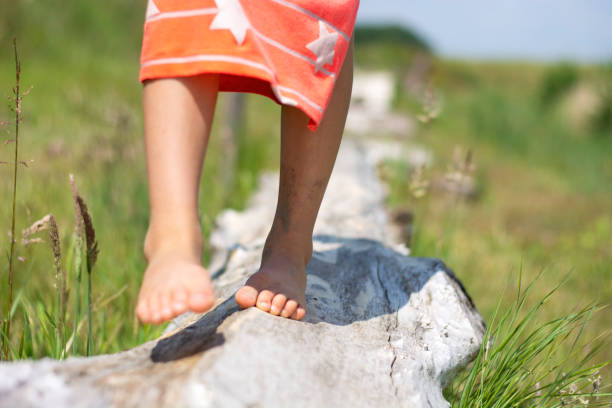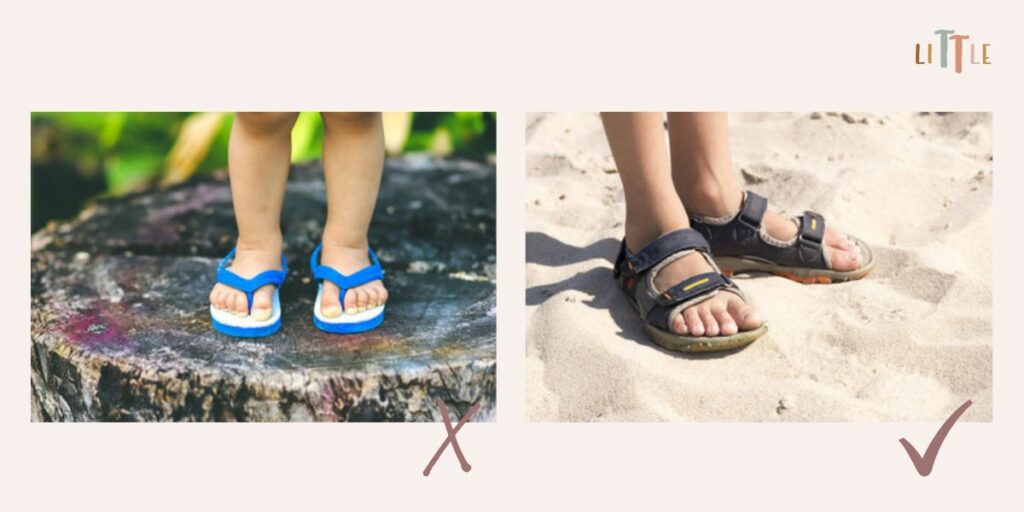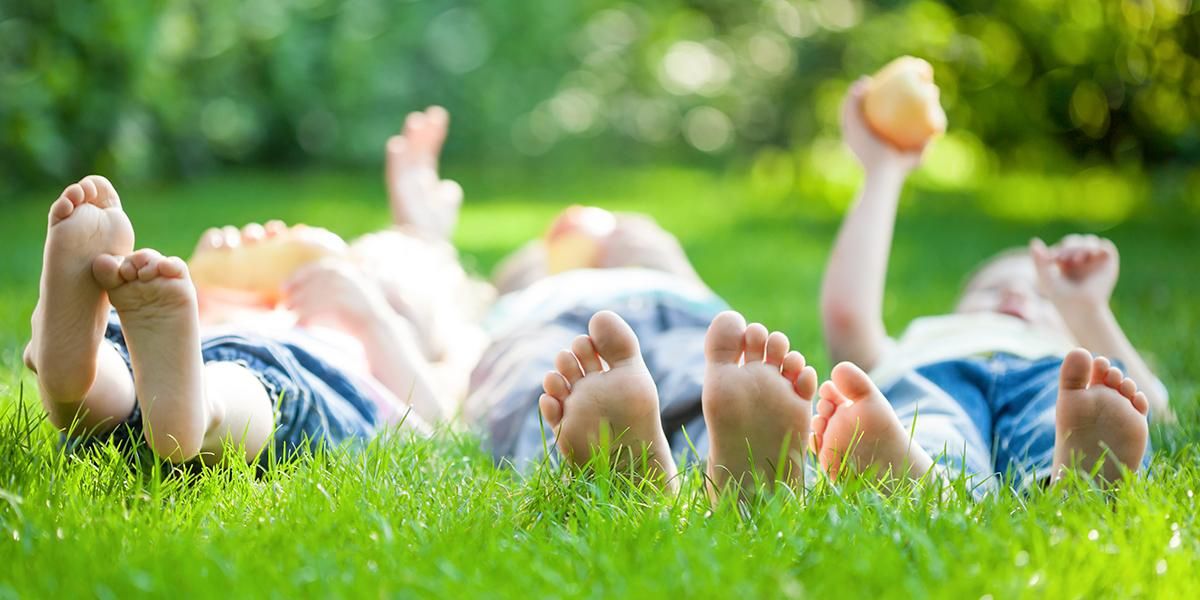As pediatric physical therapists, we often see parents who are concerned about the potential harm that could be caused by letting their child walk barefoot. However, as much as we understand the concern for protecting a child’s feet, there are many benefits to letting children walk barefoot, especially in terms of the development of their foot structure and function, as well as their gait.
TL;DR – the highlights:
- the human foot is a complex structure, which is not fully developed until adolescence
- the foot has multiple functions, including providing support to the body, shock absorption, balance and stability for standing, walking and running
- barefoot walking improves the child’s proprioception, balance, and coordination
- it helps strengthen the muscles of the feet and develops a more natural gait
- it may stimulate proper arch development and thus prevent flat feet, but evidence is conflicting
- we don’t recommend slippers or flip-flops for toddlers, as they can cause foot muscle fatigue
Foot is a complex structure
The foot is an incredibly complex structure containing 26 bones, 33 joints, and more than 100 ligaments, tendons, and muscles. Together, these structures provide support, stability, and mobility to the body. The foot is divided into three main parts: the hindfoot, the midfoot, and the forefoot. The hindfoot includes the heel and ankle bones, the midfoot includes the small bones that form the arch of the foot, and the forefoot includes the toes and the bones that connect to them. The arch of the foot is especially important for providing stability during movement, supporting body weight and for shock absorption by spreading the forces generated during walking.1 In addition to the bone structure, there is a complex set of muscles important for controlling balance and movement2, as well as receptors located in the sole for sensing the ground and loading of the foot.
Development of a child’s foot
The development of the human foot is crucial for motor learning in children and adolescents, as it provides the basic requirements for bipedal movement and stability.3 The development of a child’s foot is a gradual process that begins in utero and continues through childhood and adolescence. The mature posture of the foot is reached between 7 and 10 years of age.4 However, the end of growth is reached between the ages of 15 and 21.5
At birth, a child’s feet consist of large areas of soft tissue, and the foot is relatively flat and flexible, with a relatively low arch covered by a fat pad. As the child grows, the bones of the foot begin to harden, and the arch of the foot develops. Complete ossification of the feet occurs in the first ten years of life. Complete stiffness and resistance of all soft tissue structures (muscles, tendons, and connective tissues) is achieved only in adulthood. Tendons and ligaments have less cross-linked collagen fibers, which means they are more flexible. An increase in cross-linking improves mechanical rigidity and doesn’t appear until school age.6 Muscles become stronger after birth when gravity and movement become important. The characteristic of the muscles in the feet is that they spend about 80% of their strength on tension and only 20% on movement.7
Foot development is influenced by many factors, including age, gender, body weight, activity level and footwear habits. Body weight is associated with reduced arch height8, while more physically active children have an increased arch height.9 Age also affects the characteristics of the foot. Especially in the first years of life, the height of the foot arch increases and eventually becomes relatively stable when they reach the age of 7.10 Therefore, being barefoot can be especially influential during the child’s growing up period.
What is the function of the foot?
The human foot functions as a rigid structure for weight bearing and can also function as a flexible structure to adapt to uneven terrain. The foot and ankle perform a variety of important functions, including supporting body weight, providing balance, absorbing shock and transmitting ground reaction forces.
It acts as a foundation for the body and provides support, balance, and stability when standing, walking, and running. The arch of the foot is especially important for shock absorption and stability during movement. The foot also plays a key role in body mechanics, providing propulsion during movement and enabling walking, running, jumping and other activities.11 Additionally, the muscles and tendons in the foot work together to provide flexibility and fine motor control, allowing us to perform precise movements such as picking up small objects with our toes.

Then why is it so important that children are also barefoot?
The foot is a complex structure that must act as a rigid lever during movement and be flexible to absorb shock. To achieve this functional adaptability, the bones, muscles, and tendons of the foot must work in synergy. Altered foot function can lead to impaired gait, muscle imbalances, balance problems and a range of pathologies affecting the lower limbs.5
Let’s explore the key benefits of promoting barefoot walking in children.
1. Strengthening the muscles of the feet
Walking barefoot allows children to engage muscles in their feet that they wouldn’t normally use when wearing shoes. As mentioned earlier, the foot contains more than 100 muscles, tendons, and ligaments. Walking barefoot allows children to exercise these muscles, strengthen them and can also help prevent conditions such as flat feet. This is important because strong and flexible feet are necessary for a healthy gait, which in turn helps prevent injuries and promote good posture. Evidence shows that in adults, barefoot or minimal shoes without arch support improve foot muscle strength.12,13,14 So far, there is no evidence that walking barefoot can strengthen foot muscles in children, however, there is speculation about the effect of footwear on foot strength.14,15
NOTE: There is conflicting evidence regarding the morphological characteristics of the foot – particularly, the medial longitudinal arch. Some studies have shown a higher incidence of flat feet in children who wear shoes, while one study reported that footwear has little effect on medial longitudinal arch height.16,17,18
2. Improving the child’s proprioception, balance, and coordination
In addition, walking barefoot, especially on different surfaces such as sand, grass, and uneven ground, can help improve a child’s proprioception, which is the body’s ability to sense the position and movement of different body parts. Research has shown that children who walk barefoot have better proprioception than those who wear shoes. Good proprioception is important for children as it helps them maintain balance and coordination, which is crucial for activities such as running, jumping, and climbing.19,20 This is because the feet have to adapt to the different textures and surfaces, they encounter, which helps strengthen the muscles and tendons in the feet. This can lead to better balance, improved gait, and fewer falls.
3. Stimulate body awareness
Another important aspect is that walking barefoot allows children to feel the ground beneath their feet and can help them develop a better sense of body awareness. The soles of the feet provide crucial sensory information to a child as they learn to walk. This can also help them learn more about the world around them as they explore the different textures and surfaces, they encounter.
4. Developing a more natural gait pattern
Moreover, walking barefoot can help children develop a more natural gait. Shoes can often restrict the natural movement of the foot, which can affect a child’s gait. This can lead to conditions such as over-pronation, where the foot rolls excessively inward, or over-supination, where the foot rolls excessively outward. Both conditions can cause pain and discomfort, not only in the foot and ankle, but also in the knee and lower back. Walking barefoot can help prevent these conditions by allowing the foot to move in a more natural and healthy way. Walking barefoot allows an increased spread of the forefoot under load.16 When walking barefoot, children tend to take shorter steps, walk more slowly, and have a narrower base of support, but they tend to increase their cadence (steps per minute).17
So is it okey for toddlers to wear slippers or flip-flops?
Research has shown that it’s not recommended for young children, especially toddlers, to wear slippers or flip-flops as they learn to walk. Instead, more secure footwear such as shoes with straps may be a better option. Studies have shown that children who frequently wore slippers at an early age developed flatter feet by the time they reached 7-9 years of age, compared to children who wore shoes with straps. This suggests that wearing loose footwear at a young age may lead to a flatter arch in later childhood. Wearing slippers at a very young age (age ≤ 2 years) may have fatigued the foot muscles instead of strengthening them and prevented the proper development of the arch. The reason is that the slippers don’t have adjustable fastenings to firmly secure the foot to the footwear. 13

In conclusion, as pediatric physical therapists, we believe that the benefits of barefoot walking for children are numerous. From developing strong and flexible feet, to improving proprioception, balance, and gait, to developing a better sense of body awareness and promoting natural movement, barefoot walking is an important part of a child’s physical development. We recommend that parents allow their children to walk barefoot as much as possible, especially on natural surfaces such as grass and sand. However, parents should also be aware of potential dangers and always supervise children when walking barefoot outside. Parents should also be mindful to provide appropriate shoes when the situation demands it, such as in a cold weather, or when the surface is not safe.
REFERENCES
- McKeon PO, Hertel J, Bramble D, Davis I. The foot core system: a new paradigm for understanding intrinsic foot muscle function. Br J Sports Med. 2015 Mar;49(5):290. doi: 10.1136/bjsports-2013-092690
- Kavounoudias A, Roll R, Roll JP. Foot sole and ankle muscle inputs contribute jointly to human erect posture regulation. J Physiol. 2001 May 1;532(Pt 3):869-78. doi: 10.1111/j.1469-7793.2001.0869e.x
- Hollander, K., de Villiers, J.E., Sehner, S. et al. Growing-up (habitually) barefoot influences the development of foot and arch morphology in children and adolescents. Sci Rep. 2017; 7: 8079. doi: 10.1038/s41598-017-07868-4
- Cappello T, Song KM. Determining treatment of flatfeet in children. Curr Opin Pediatr. 1998 Feb;10(1):77-81. doi: 10.1097/00008480-199802000-00016
- Squibb M, Sheerin K, Francis P. Measurement of the Developing Foot in Shod and Barefoot Paediatric Populations: A Narrative Review. Children (Basel). 2022 May 19;9(5):750. doi: 10.3390/children9050750
- Fritz BB, Mauch M. Foot development in childhood and adolescence. Woodhead Publishing Series in Textiles. 2013; 49-71.
- Matthews JG. The developmental anatomy of the foot. The Foot. 1998; 8:17-25.
- Mickle KJ, Steele JR, Munro BJ. The feet of overweight and obese young children: are they flat or fat? Obesity (Silver Spring). 2006 Nov;14(11):1949-53. doi: 10.1038/oby.2006.227
- Truszczyńska-Baszak, Aleksandra, Drzał-Grabiec, Justyna, Rachwał, Maciej, Chałubińska, Dorota and Janowska, Edyta. Correlation of physical activity and fitness with arches of the foot in children. Biomedical Human Kinetics. 2017; 9(1): 19-26. doi: https://doi.org/10.1515/bhk-2017-0004
- Müller S, Carlsohn A, Müller J, Baur H, Mayer F. Static and dynamic foot characteristics in children aged 1-13 years: a cross-sectional study. Gait Posture. 2012 Mar;35(3):389-94. doi: 10.1016/j.gaitpost.2011.10.357
- Farris DJ, Kelly LA, Cresswell AG, Lichtwark GA. The functional importance of human foot muscles for bipedal locomotion. Proc Natl Acad Sci U S A. 2019 Jan 29;116(5):1645-1650. doi: 10.1073/pnas.1812820116
- Miller E.E., Whitcome K.K., Lieberman D.E., Norton H.L., Dyer R.E. The Effect of Minimal Shoes on Arch Structure and Intrinsic Foot Muscle Strength. J. Sport Health Sci. 2014;3:74–85. doi: 10.1016/j.jshs.2014.03.011.
- Ridge ST, Olsen MT, Bruening DA, Jurgensmeier K, Griffin D, Davis IS, Johnson AW. Walking in Minimalist Shoes Is Effective for Strengthening Foot Muscles. Med Sci Sports Exerc. 2019 Jan;51(1):104-113. doi: 10.1249/MSS.0000000000001751
- Holowka NB, Wallace IJ, Lieberman DE. Foot strength and stiffness are related to footwear use in a comparison of minimally- vs. conventionally-shod populations. Sci Rep. 2018 Feb 27;8(1):3679. doi: 10.1038/s41598-018-21916-7
- Tong JW, Kong PW. Medial Longitudinal Arch Development of Children Aged 7 to 9 Years: Longitudinal Investigation. Phys Ther. 2016 Aug;96(8):1216-24. doi: 10.2522/ptj.20150192
- Franklin S, Grey MJ, Heneghan N, Bowen L, Li FX. Barefoot vs common footwear: A systematic review of the kinematic, kinetic and muscle activity differences during walking. Gait Posture. 2015 Sep;42(3):230-9. doi: 10.1016/j.gaitpost.2015.05.019
- Morrison SC, Price C, McClymont J, Nester C. Big issues for small feet: developmental, biomechanical and clinical narratives on children’s footwear. J Foot Ankle Res. 2018 Jul 6;11:39. doi: 10.1186/s13047-018-0281-2
- Hollander K, Heidt C, VAN DER Zwaard BC, Braumann KM, Zech A. Long-Term Effects of Habitual Barefoot Running and Walking: A Systematic Review. Med Sci Sports Exerc. 2017 Apr;49(4):752-762. doi: 10.1249/MSS.0000000000001141
- Quinlan S, Sinclair P, Hunt A, Yan AF. The long-term effects of wearing moderate minimalist shoes on a child’s foot strength, muscle structure and balance: A randomised controlled trial. Gait Posture. 2022 Feb;92:371-377. doi: 10.1016/j.gaitpost.2021.12.009
- Zech A, Venter R, de Villiers JE, Sehner S, Wegscheider K, Hollander K. Motor Skills of Children and Adolescents Are Influenced by Growing up Barefoot or Shod. Front Pediatr. 2018 Apr 25;6:115. doi: 10.3389/fped.2018.00115

